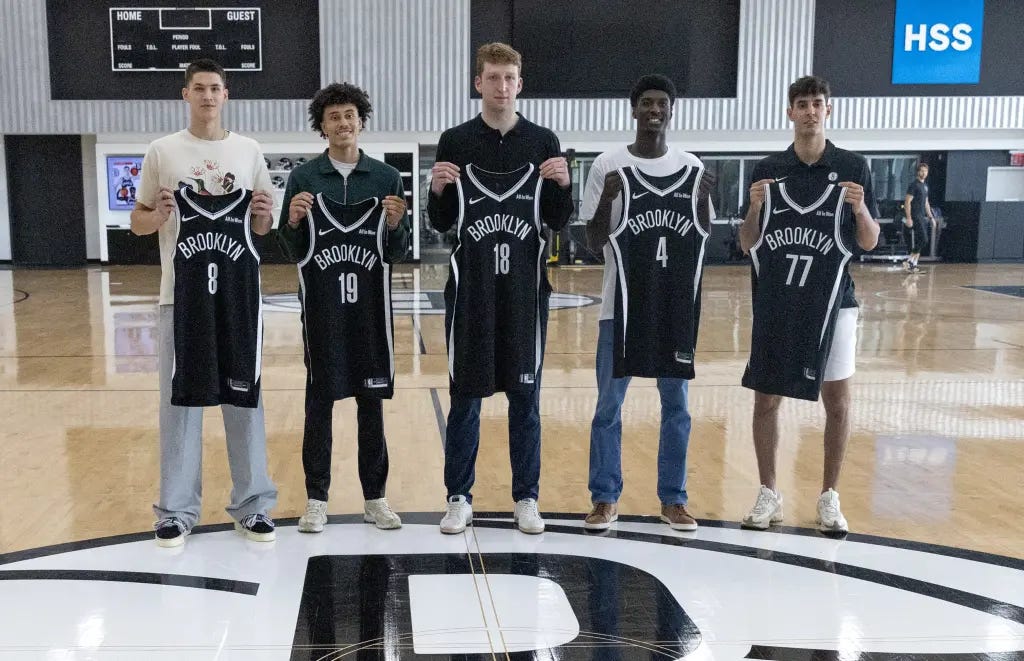What To Watch In Nets Summer League Games
The NBA Summer League isn’t for basketball purists with weak stomachs. Those sated by a thrilling postseason that concluded a mere two weeks ago can find it difficult to adjust to a new diet of ill-advised decisions and executions on the Las Vegas courts. It can get nauseatingly ugly.
The games themselves are utterly meaningless, and I would urge caution when noting takeaways on player performances, as they are often not translatable to regular season action. See: Wilson, Jalen, 2024 NBA Summer League MVP.
However, there have been instances where player improvements in Summer Leagues have carried over—not just Cam Thomas a few years ago, but I can go back to Richard Jefferson in 2002 where it was clear from how those players moved on the court that they were due for a leap. Mostly, though, the tournament’s stars are lucky if they can find a seat at the end of a bench come October.
Nets fans who are eager to watch their five first-round picks (plus an assortment of recognizable players from last season like Drew Timme and Tosan Evbuomwan, but not perpetually injured third year player Dariq Whitehead) should disregard results. I’m not expecting these guys who barely knocked down 30% of their three-pointers last season, if that, to start raining shots from deep in this sloppy setting.
Here's some specifics on what I will be focusing on when Summer League action kicks off on Thursday when the Nets face the Thunder:
1) Drake Powell’s defensive activity
At this stage of his career, Powell’s defense is allegedly well ahead of his offense. Let’s see it. Summer League rules, with its 10-foul limit, allow players to hack like crazy, so there’s no excuse for Powell, Brooklyn’s No. 22 overall pick, to hold back on the physicality. Nets Head Coach Jordi Fernandez demanded that his guards get into ballcarriers’ grills last season like Oklahoma City and Indiana does, even when it was obvious to the world they were going to be beaten off the dribble. I want to see how Powell, 19, navigates screens from more mature bigs. Can he get through them or at least recover without ricocheting toward the midcourt line? How active are his hands? Some so-called “stocks” (steals plus blocks) would be nice, especially when they come from weakside help, but the SL numbers are not as essential. Anecdotally (I don’t have a Second Spectrum subscription to get the rankings), the Nets were quite susceptible to blow-bys last season, constantly putting their team defense in scramble mode. Powell will have time to develop an offensive bag, but it will be his ability to contain lead guards that will get him playing time in games that matter.
2) Nolan Traore’s first step
We’ve heard a bunch about Traore’s speed in the lead-up to his No. 19 overall selection. I’ve seen comparisons to fellow Frenchman Tony Parker. It took the Basketball Hall-of-Famer Parker about a decade to become somewhat proficient with his distance shooting, but that was a different era—he was relatively lethal from mid-range areas. Again, don’t be concerned if Traore, also 19, throws up some hideous-looking shots in these games; he’s going to be encouraged by Nets assistant coach Steve Hetzel, who is running the Summer League team, to fire away at will on those looks, where he was inconsistent (just under 30%) during his two-year stint as a French pro. However, with Summer League defenders typically guarding tight, Traore should have opportunities to show off his quickness. The Nets really didn’t have a player capable of beating opponents with speed off the bounce after Dennis Schroder was traded last December; D’Angelo Russell and Thomas mainly used their guile and body positioning to get to their spots. The Nets could potentially use this dimension from Traore going forward.
3) Egor Demin creating advantages
I’m still shaking my head over this No. 8 overall pick, but I’m willing to have more of an open mind on Demin, also 19, if I can see glimpses this summer of how he can enhance Brooklyn’s offense. Don’t just tell me he can pass. So could Ben Simmons, and he was generally a drag on the Nets’ attack (when he was healthy enough to suit up) with the exception of the brief period when he had the privilege of playing with Kevin Durant, who at the time made everyone look better. Demin is supposedly an expert at pick-and-rolls. Well, can he turn corners to get in the paint and force help? Can he beat blitzes with dribbles, not just passes? My impressions of him in college were not great—BYU often utilized the older Richie Saunders on the ball on key possessions. The stat that stood out to me: In 20 Big 12 conference games, Demin recorded only eight more field goals (71) than turnovers (63), though to be fair he also posted 110 assists. He was worse (3-for-13 shooting, 7 assists and 9 turnovers) in the two conference tournament games before steadying himself a bit in the Cougars’ run to the NCAA’s Sweet 16. I don’t care that Demin looked fantastic shooting against air during the pre-Draft process. So does Day’Ron Sharpe. Demin shot 27.3% on 3s from the shorter college distance. I’ll grant him a learning curve for this level, but he still has to find ways to score. His approximately 6-foot 9 height that allows him to see the floor can’t be his only advantage. Otherwise, this rare Nets lottery pick will end up in the trash after a few years.



